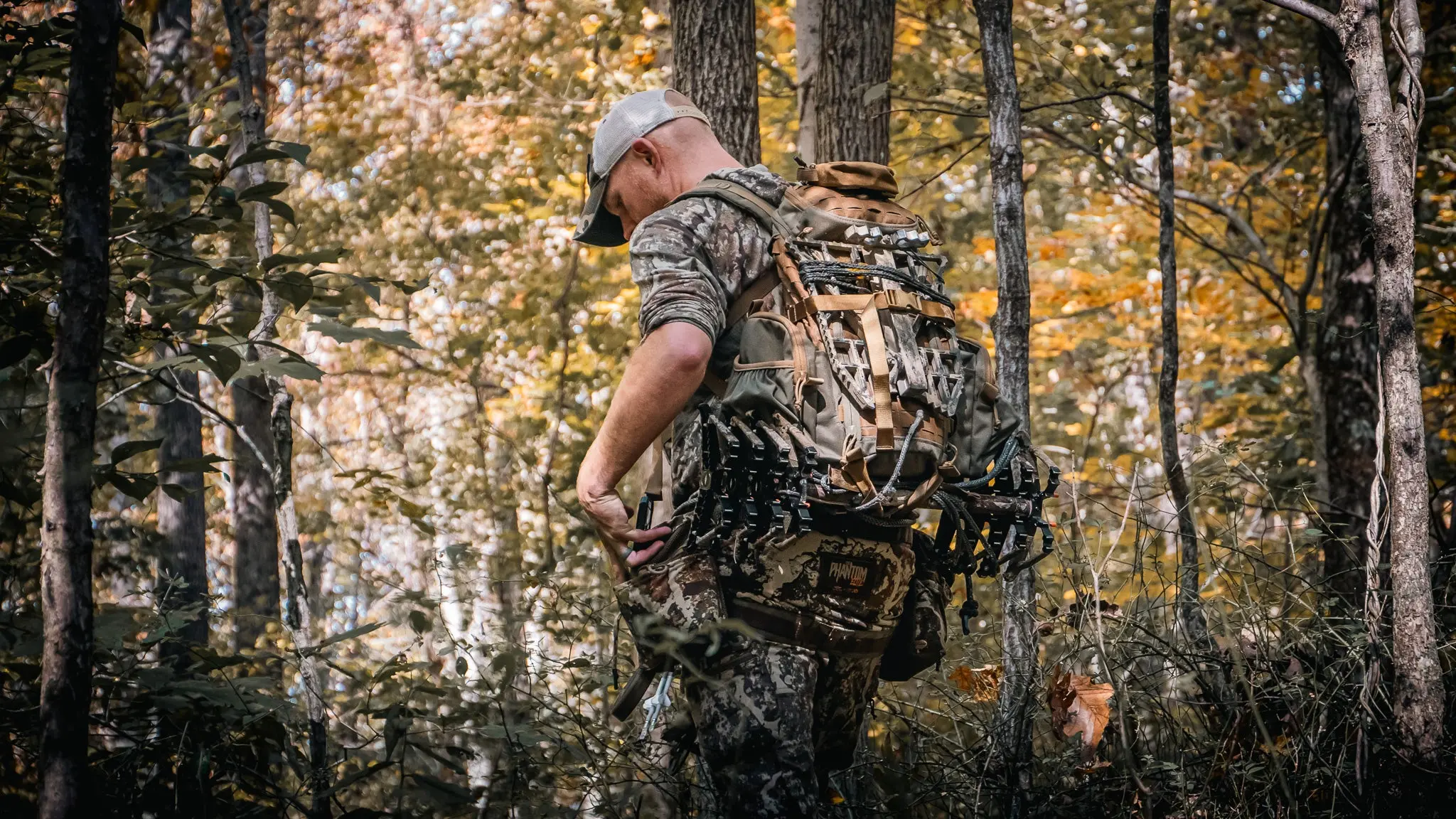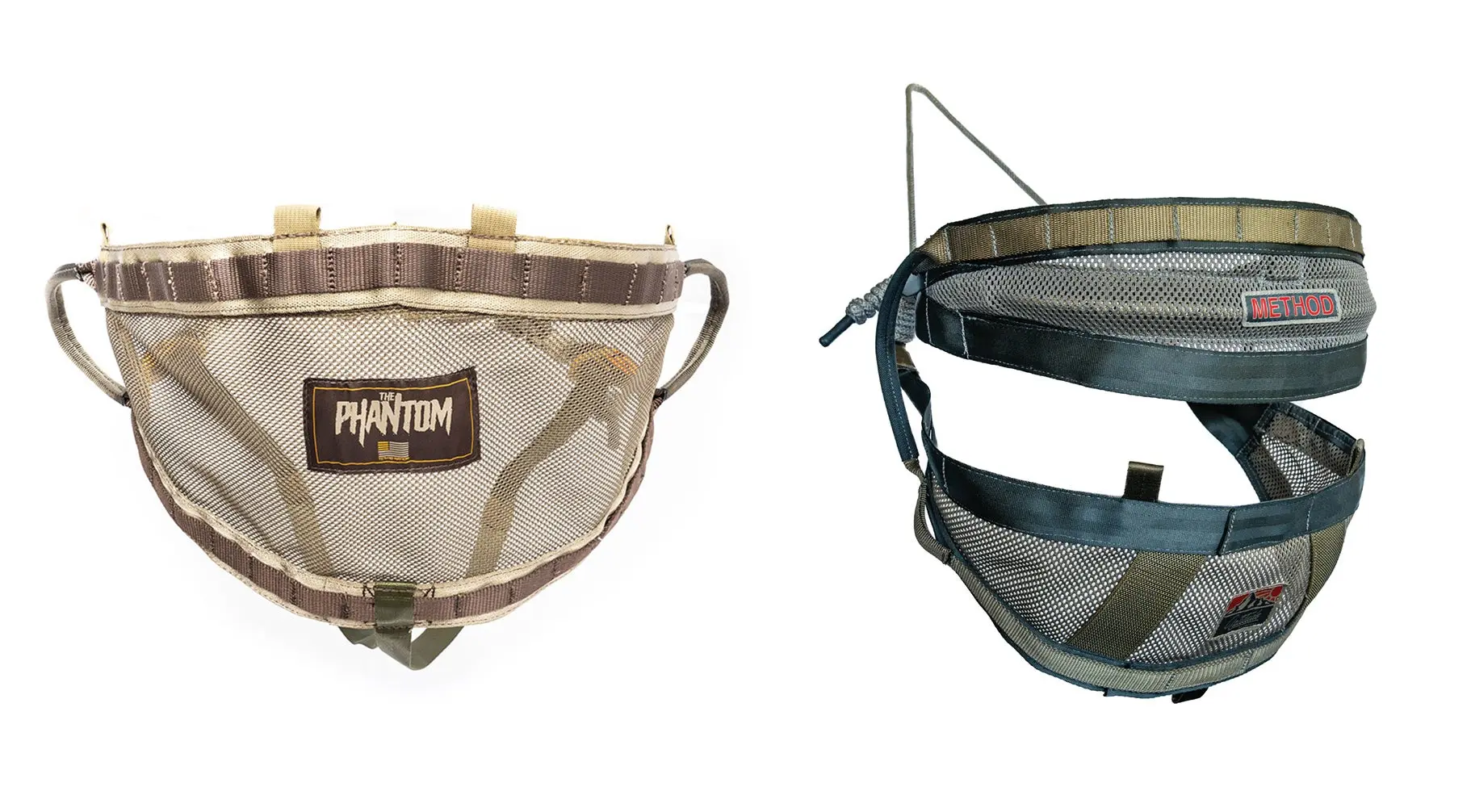_We may earn revenue from the products available on this page and participate in affiliate programs. Learn more ›
_
Hiking into a hunting area with a tree stand strapped to my back is a labor of love that I’ve endured many, many times. It’s also one that I don’t need to endure again, thanks to saddle hunting. Backcountry hunting from a tree saddle instead of a tree stand has taken the deer hunting world by storm—and for good reason. Saddle hunting is a quick, efficient, and effective method for hunting from an elevated position, and the required gear is lightweight, versatile, and highly portable. All of which explains why I’ve joined the legions of saddle hunters. And so should you. Here’s everything you need to know to get stared at saddle hunting.
What Is Saddle Hunting?
Saddle hunting is more or less just what it sound like: instead of standing on the platform of tree stand, you sit in a saddle—a seat made of strong but lightweight fabric—that’s tethered to the tree via a rope tether. You put your saddle on, much like you would a typical tree-stand harness. Then you climb the tree, typically using portable climbing sticks. But when you get to the height at which you want to hunt, instead of having to install a stand, you just secure your tether and sit in the saddle you’re already wearing. When saddle hunting, you face the trunk of the tree rather than away from it, and you just turn your body to take a shot.
Tree Saddles vs Tree Stands

Tree saddles are perfect for hunting remote areas because they lighter and less cumbersome to carry than a tree stand. Rob Mendoza / Tethrd
Both a saddle and a tree stand provide the same tactical advantage when hunting in that they put you in an elevated position, above a deer’s normal line of sight. But each one delivers that lofty view in its own way. Tree stands have large platforms for standing on and stationary, rigid seats for sitting. Saddles, on the other hand, do not include a standing platform (though most hunters opt to use a comparatively small one as an accessory) and there is no stationary seat. The saddle itself serves as the hunter’s seat.
So why use one over the other? It all boils down to how mobile you want to be for a given hunt. If you want to sit in a perennial hotspot on the back 40, then it makes perfect sense to hang a good traditional tree stand
and leave it there for subsequent hunts. But if you want to hike to remote hotspots for day hunts, it makes a lot more sense to hunt from a saddle—which is smaller, lighter, and easier to set up than a tree stand. For these reasons, saddle hunting has become hugely popular with public-land bowhunters.
What You Need For Saddle Hunting

Tree saddles come in one-panel designs, like the Tethrd Phantom (left) or two-panel, like the Latitude Outdoors Method 2 (right). Tethrd / Latitude Outdoors
The biggest advantage of saddle hunting is the simplicity of it. You only need a few things to get started, including:
A Saddle. There are lots of great options on the market. You can choose a single-panel design, like Tethrd’s popular Phantom
, or a double-panel model, like The Method 2 by Latitude Outdoors
. Both work great, but whereas a single-panel saddle is a fixed width (from top to bottom), a double-panel saddle has adjustable straps between the panels, allowing you to customize the width of your seat.
Climbing Aids. For saddle hunting, most people us either multiple nesting, lightweight climbing sticks, or they use a single climbing stick and reposition it as they climb.
Tether Rope. This attaches to your saddle on one end and the tree on the other.
Lineman’s Rope: This attaches to your saddle and wraps around the tree to aid in climbing, as well as climbing safety.
Although that is all you need to get started, you can add a small platform to stand on; it’s not a necessary item but most saddle hunter do opt to use one. Saddle-mounted stash bags are also popular and are handy for storing your tether or lineman’s rope when not in use, as well as quick-grab items like hanger hooks, rangefinders, and other gear.
Saddle Hunting Set Up
See HOW TO SADDLE HUNT - Jake's Mobile Setupon YouTube
The first order of business is to choose the tree you want to hunt from. With a saddle, this is a pretty simple task because just about any tree that will readily support your weight will do. Unlike traditional tree stands, you don’t have to worry nearly as much about trees that lean or twist when using a saddle.
Once you’ve picked your tree, it’s time to climb. There’s no shortage of climbing methods to choose from and the popularity of mobile hunting from saddles has greatly expanded the options. Regardless of what climbing system you choose, the goal should to be to get 17 feet or hight off the ground. That said, you can hunt a bit higher or lower depending on your comfort level, cover, and shot options.
Keep in mind the direction you expect game to approach from, and remember that you’ll be set up facing the trunk of the tree. I like to position myself so that the trunk of the tree is between me and an approaching deer. Ideally, I want the deer to walk past my tree and present a shot on my left-hand side, since I’m a right-handed shooter. This is what saddle hunters mean when they say they want to have a strong-side shot opportunity in most situations.
Shooting From a Tree Saddle

With practice, you can shoot from almost any angle from a tree saddle. Rob Mendoza / Tethrd
Although most saddle hunters will set up for a strong-side shot, weak-side shots are very doable as well. Unlike traditional tree stands, a saddle allows you to shoot in just about any direction, but you need to practice getting your body into different positions around the tree and working around the tether rope. Once you get the hand of it, taking shots from a variety of angles and position becomes second nature.
Saddle Hunting Tips
1. Start in the Backyard
When first using a saddle, start with backyard practice sessions and position yourself just a foot or so off the ground. Getting comfortable in the saddle is critical and being close the ground helps tremendously. This is the place to practice shots from different angles. Set up a few targets around your tree, and go gradually higher as you get more comfortable.
2. Keep Your Saddle Hunting Setup Simple
Don’t get carried away with bags and accessories. Too much garbage hanging off your saddle makes it cumbersome to move and will reduce your feeling of stability in the air. Remember that the whole purpose of saddle hunting is to travel light and be highly mobile, so don’t weigh yourself down with too much gear.
3. Shoot from the Strong-Side
Don’t treat a saddle as a stationary stand. Off-side shots are doable, but strong-side shots are much easier. Remember, you can position your tether in different areas on the tree to allow for movement around the tree, thus creating multiple strong-side shot options. Practice weak-side shots, for sure. But also learn how to shoot from your strong side whenever possible, and you’ll ultimately have better success while saddle hunting.

